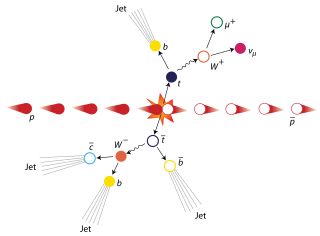Related Research Articles
In physical cosmology, cosmic inflation, cosmological inflation, or just inflation, is a theory of exponential expansion of space in the early universe. The inflationary epoch is believed to have lasted from 10−36 seconds to between 10−33 and 10−32 seconds after the Big Bang. Following the inflationary period, the universe continued to expand, but at a slower rate. The acceleration of this expansion due to dark energy began after the universe was already over 7.7 billion years old.

In nuclear physics, the island of stability is a predicted set of isotopes of superheavy elements that may have considerably longer half-lives than known isotopes of these elements. It is predicted to appear as an "island" in the chart of nuclides, separated from known stable and long-lived primordial radionuclides. Its theoretical existence is attributed to stabilizing effects of predicted "magic numbers" of protons and neutrons in the superheavy mass region.
Doubly special relativity (DSR) – also called deformed special relativity or, by some, extra-special relativity – is a modified theory of special relativity in which there is not only an observer-independent maximum velocity, but also, an observer-independent maximum energy scale and/or a minimum length scale. This contrasts with other Lorentz-violating theories, such as the Standard-Model Extension, where Lorentz invariance is instead broken by the presence of a preferred frame. The main motivation for this theory is that the Planck energy should be the scale where as yet unknown quantum gravity effects become important and, due to invariance of physical laws, this scale should remain fixed in all inertial frames.

The top quark, sometimes also referred to as the truth quark, is the most massive of all observed elementary particles. It derives its mass from its coupling to the Higgs Boson. This coupling is very close to unity; in the Standard Model of particle physics, it is the largest (strongest) coupling at the scale of the weak interactions and above. The top quark was discovered in 1995 by the CDF and DØ experiments at Fermilab.
An axion is a hypothetical elementary particle originally postulated by the Peccei–Quinn theory in 1977 to resolve the strong CP problem in quantum chromodynamics (QCD). If axions exist and have low mass within a specific range, they are of interest as a possible component of cold dark matter.
In physics, mirror matter, also called shadow matter or Alice matter, is a hypothetical counterpart to ordinary matter.

Exotic baryons are a type of hadron with half-integer spin, but with a quark content different from the three quarks (qqq) present in conventional baryons. An example would be pentaquarks, consisting of four quarks and one antiquark (qqqqq̅).
Strongly interacting massive particles (SIMPs) are hypothetical particles that interact strongly between themselves and weakly with ordinary matter, but could form the inferred dark matter despite this.

In quantum field theory, a false vacuum is a hypothetical vacuum that is relatively stable, but not in the most stable state possible. This condition is known as metastable. It may last for a very long time in that state, but could eventually decay to the more stable state, an event known as false vacuum decay. The most common suggestion of how such a decay might happen in our universe is called bubble nucleation – if a small region of the universe by chance reached a more stable vacuum, this "bubble" would spread.
This is a timeline of subatomic particle discoveries, including all particles thus far discovered which appear to be elementary given the best available evidence. It also includes the discovery of composite particles and antiparticles that were of particular historical importance.
The Askaryan radiation also known as Askaryan effect is the phenomenon whereby a particle traveling faster than the phase velocity of light in a dense dielectric produces a shower of secondary charged particles which contains a charge anisotropy and thus emits a cone of coherent radiation in the radio or microwave part of the electromagnetic spectrum. It is similar to the Cherenkov radiation. It is named after Gurgen Askaryan, a Soviet-Armenian physicist who postulated it in 1962.
In particle physics, the lightest supersymmetric particle (LSP) is the generic name given to the lightest of the additional hypothetical particles found in supersymmetric models. In models with R-parity conservation, the LSP is stable; in other words, it cannot decay into any Standard Model particle, since all SM particles have the opposite R-parity. There is extensive observational evidence for an additional component of the matter density in the universe, which goes under the name dark matter. The LSP of supersymmetric models is a dark matter candidate and is a weakly interacting massive particle (WIMP).
In particle physics and string theory (M-theory), the ADD model, also known as the model with large extra dimensions (LED), is a model framework that attempts to solve the hierarchy problem. The model tries to explain this problem by postulating that our universe, with its four dimensions, exists on a membrane in a higher dimensional space. It is then suggested that the other forces of nature operate within this membrane and its four dimensions, while the hypothetical gravity-bearing particle graviton can propagate across the extra dimensions. This would explain why gravity is very weak compared to the other fundamental forces. The size of the dimensions in ADD is around the order of the TeV scale, which results in it being experimentally probeable by current colliders, unlike many exotic extra dimensional hypotheses that have the relevant size around the Planck scale.
A strangelet is a hypothetical particle consisting of a bound state of roughly equal numbers of up, down, and strange quarks. An equivalent description is that a strangelet is a small fragment of strange matter, small enough to be considered a particle. The size of an object composed of strange matter could, theoretically, range from a few femtometers across to arbitrarily large. Once the size becomes macroscopic, such an object is usually called a strange star. The term "strangelet" originates with Edward Farhi and Robert Jaffe in 1984. Strangelets can convert matter to strange matter on contact. Strangelets have been suggested as a dark matter candidate.
Thomas Carlos Mehen is an American physicist. His research has consisted of primarily Quantum chromodynamics (QCD) and the application of effective field theory to problems in hadronic physics. He has also worked on effective field theory for non-relativistic particles whose short range interactions are characterized by a large scattering length, as well as novel field theories which arise from unusual limits of string theory.
In particle physics, W′ and Z′ bosons refer to hypothetical gauge bosons that arise from extensions of the electroweak symmetry of the Standard Model. They are named in analogy with the Standard Model W and Z bosons.
The Bousso bound captures a fundamental relation between quantum information and the geometry of space and time. It appears to be an imprint of a unified theory that combines quantum mechanics with Einstein's general relativity. The study of black hole thermodynamics and the information paradox led to the idea of the holographic principle: the entropy of matter and radiation in a spatial region cannot exceed the Bekenstein–Hawking entropy of the boundary of the region, which is proportional to the boundary area. However, this "spacelike" entropy bound fails in cosmology; for example, it does not hold true in our universe.

In astrophysics and cosmology scalar field dark matter is a classical, minimally coupled, scalar field postulated to account for the inferred dark matter.

Modern searches for Lorentz violation are scientific studies that look for deviations from Lorentz invariance or symmetry, a set of fundamental frameworks that underpin modern science and fundamental physics in particular. These studies try to determine whether violations or exceptions might exist for well-known physical laws such as special relativity and CPT symmetry, as predicted by some variations of quantum gravity, string theory, and some alternatives to general relativity.
Daniel S. Akerib is an American particle physicist and astrophysicist. He was elected in 2008 a fellow of the American Physical Society (APS).
References
- John Ellis; Jorge L. Lopez; D.V. Nanopoulos (1990). "Confinement of fractional charges yields integer-charged relics in string models". Physics Letters B. 247 (2–3): 257–264. Bibcode:1990PhLB..247..257E. doi:10.1016/0370-2693(90)90893-B. hdl: 1969.1/181059 .
- Karim Benakli; John Ellis; D.V. Nanopoulos (1999). "Natural Candidates for Superheavy Dark Matter in String and M Theory". Physical Review D. 59 (4): 047301. arXiv: hep-ph/9803333 . Bibcode:1999PhRvD..59d7301B. doi:10.1103/PhysRevD.59.047301. S2CID 119382848.
- John Ellis; V.E. Mayes; D.V. Nanopoulos (2004). "Flipped Cryptons and the Ultra-high Energy Cosmic Rays". Physical Review D. 70 (7): 075015. arXiv: hep-ph/0403144 . Bibcode:2004PhRvD..70g5015E. doi:10.1103/PhysRevD.70.075015. S2CID 119360169.
- John Ellis; V.E. Mayes; D.V. Nanopoulos (2006). "Ultrahigh Energy Cosmic Ray Particle Spectra from Crypton Decays". Physical Review D. 74 (11): 115003. arXiv: astro-ph/0512303 . Bibcode:2006PhRvD..74k5003E. doi:10.1103/PhysRevD.74.115003. S2CID 119382442.